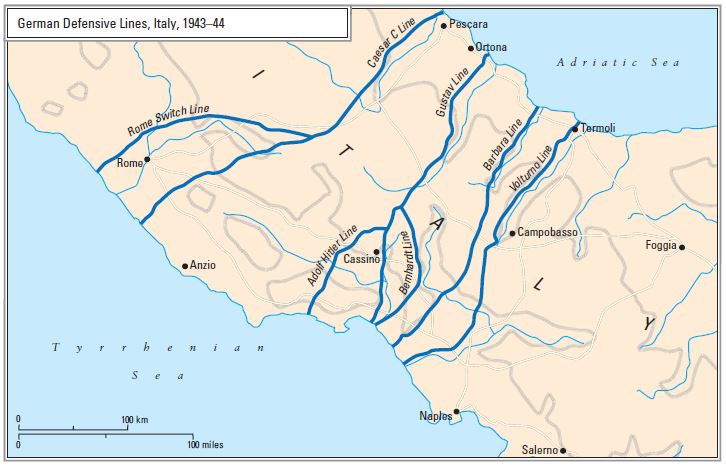Editor: Michael Spilling and Consultant Editor: Chris McNab
The Gustav-Cassino Line was a German defensive position constructed in late 1943 across Italy. From Gaeta, south of Rome, through Cassino, the Apennine Mountains and stretched onto the Sangro estuary on the eastern coast. It took the Western Allies four offensives to break this position. The optimal Allied route of advance to Rome was through the Liri Valley. However, the Gustav defences blocked this route around Cassino, particularly on the Monte Cassino heights, topped by its ancient monastery. In the First Battle of Monte Cassino (17 January–11 February 1944). X Corps’ three British divisions attacked across the Garigilano River close to the western coast, while three Fifth US Army divisions attacked Cassino.

Subsequently, Allied forces landed behind the Garigliano at Anzio. The Allies closed on the monastery before being halted. During the second battle (15–18 February), one New Zealand and one Indian division attacked the Cassino defenses to assist the beleaguered Anzio beachhead. Despite incurring high casualties and destroying the monastery, the Allies again failed to capture Monastery Hill. In the third battle (15–26 March), three Allied divisions attacked Cassino from the northeast. However, the Allied advance was again halted short of the monastery.
The final battle of the Gustav-Cassino Line
In the fourth battle (11–25 May), Operation Diadem, US Fifth Army and British Eighth Army forces attacked the Gustav Line’s western sector in a large-scale offensive. While the US II and French I Corps assaulted across the Garigliano and US VI Corps broke out from the Anzio beachhead, Polish II and British XIII Corps assaulted the Cassino position. This offensive broke through Cassino. By late May, the German forces were in full retreat north beyond Rome. The Allies suffered 55,000 casualties in these operations, while the Germans took 35,000.
Dr. Chris McNab is the editor of AMERICAN BATTLES & CAMPAIGNS: A Chronicle, from 1622-Present and is an experienced specialist in wilderness and urban survival techniques. He has published over 20 books including: How to Survive Anything, Anywhere. An encyclopedia of military and civilian survival techniques for all environments. Special Forces Endurance Techniques, First Aid Survival Manual, and The Handbook of Urban Survival.
